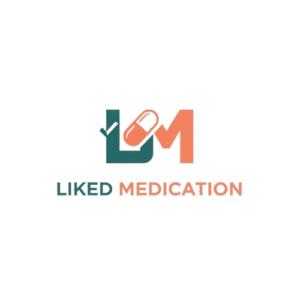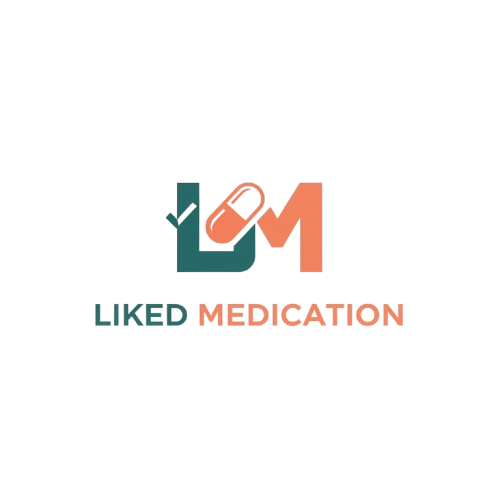Introduction: Start of the 2025 RSV Season
The 2025 Respiratory Syncytial Virus (RSV) season officially began in Week 11 (starting March 10, 2025), according to the National Institute for Communicable Diseases (NICD). This alert signals clinicians to prepare for rising RSV cases and implement evidence-based prevention strategies, particularly for infants, young children, and vulnerable adults.
Understanding the timing of the RSV season is critical, as it helps clinicians align prophylaxis schedules, maternal vaccinations, and public health interventions to reduce the burden of severe disease.
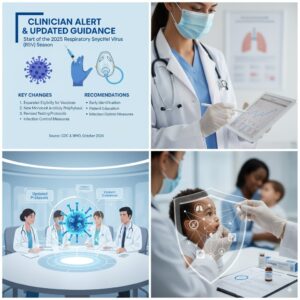
Epidemiology of RSV Season.
RSV season tracking is based on laboratory surveillance and case detection rates. Typically, the season is declared when a three-week moving average of RSV-positive tests surpasses a defined threshold.
- Regional variation matters:
- In South Africa, the 2025 RSV season began in March (earlier than influenza season).
- In the United States, RSV activity usually peaks between October and March, though regional differences exist.
Surveillance systems help clinicians anticipate caseloads and guide preventive measures such as nirsevimab administration and maternal vaccination.
Clinical Significance of RSV
RSV remains a leading cause of lower respiratory tract infections in infants, toddlers, and high-risk adults.
High-risk groups include:
- Infants under 6 months, especially premature babies
- Children with chronic lung or congenital heart disease
- Immunocompromised individuals
- Older adults (65+) and those with comorbidities
Severe RSV can lead to bronchiolitis, pneumonia, hospitalization, and mortality, making early-season preparedness essential.
Updated RSV Prophylaxis Guidelines (2025)
- Infant Protection: Nirsevimab (Beyfortus®)
- Timing: Administered prior to or during RSV season.
- Eligibility: All infants under 8 months entering their first RSV season; certain high-risk infants up to 24 months.
- Season End Date: Per 2025 guidance, administration should stop after March 31.
Nirsevimab provides long-lasting passive immunity and is now a cornerstone of RSV prevention in pediatrics.
- Maternal Vaccination: Abrysvo®
- Timing: Recommended at 32–36 weeks gestation if delivery is expected between September 1 and January 31.
- Benefit: Transplacental antibody transfer protects infants during their most vulnerable months.
- Regional Seasonality Differences
- South Africa 2025: RSV season began March 10 (Week 11).
- United States 2025: Season typically October–March, aligning with prophylaxis and vaccination windows.
Clinicians should adjust strategies based on local RSV surveillance data rather than relying solely on national averages.
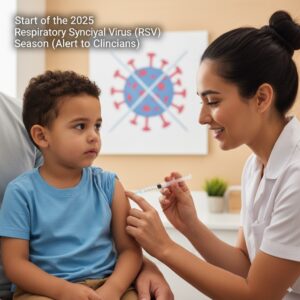
Call to Action for Clinicians
To ensure optimal patient outcomes during the 2025 RSV season, healthcare providers should:
- Coordinate with public health authorities for surveillance updates and thresholds.
- Educate parents about RSV prevention, symptoms, and the role of prophylaxis.
- Prioritize prophylaxis for infants at highest risk.
- Integrate maternal RSV vaccination into prenatal care planning.
- Prepare healthcare systems for potential surges in pediatric hospitalizations.
Frequently Asked Questions (FAQ)
- When did the 2025 RSV season start?
The official start was Week 11, March 10, 2025, per NICD surveillance. - When should clinicians stop administering nirsevimab?
No doses should be given after March 31, 2025, for the 2024–25 season. - How does RSV season differ by region?
- South Africa: March–June.
- United States: October–March.
- What vaccines or antibodies are available in 2025?
- Nirsevimab (Beyfortus®) for infants and young children.
- Abrysvo® maternal RSV vaccine for protection via pregnancy.
- Who is most at risk for severe RSV?
Infants under 6 months, premature babies, children with chronic health conditions, older adults, and immunocompromised patients.
Conclusion
The start of the 2025 RSV season (March 10, 2025) underscores the importance of clinician readiness. With updated tools like nirsevimab for infants and maternal RSV vaccination, healthcare providers have effective strategies to reduce RSV hospitalizations and complications.
Clinicians should remain vigilant, follow local surveillance data, and educate families about RSV prevention. Proactive coordination now will ensure better outcomes throughout the RSV season.
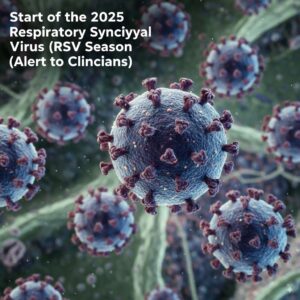
Global Review of RSV (Respiratory Syncytial Virus)
Respiratory Syncytial Virus (RSV) is one of the most common causes of respiratory infections worldwide. It affects all age groups, but it is especially dangerous for infants, young children, older adults, and people with weakened immune systems.
Global Situation
- Infants & Children: RSV is the leading cause of bronchiolitis and pneumonia in children under 5 years.
- Hospitalizations: Each year, RSV leads to millions of hospital admissions worldwide, especially in babies under 6 months.
- Older Adults: RSV is increasingly recognized as a cause of serious illness in adults over 60, often similar in severity to influenza.
- Seasonal Patterns: RSV occurs in seasonal waves:
- In the U.S. and Europe → usually October–March.
- In South Africa and parts of the southern hemisphere → often starts around March–June.
With new preventive tools like nirsevimab (Beyfortus®) for infants and maternal vaccination (Abrysvo®), the global outlook is improving, but access and affordability remain challenges in many countries
Risks of RSV Infection
Although most RSV infections cause mild cold-like symptoms, certain groups face serious complications:
- Infants and Young Children
- Premature babies
- Infants under 6 months
- Children with chronic lung or heart disease
- Those with weak immune systems
Complications: Bronchiolitis, pneumonia, difficulty breathing, dehydration, hospitalization.
- Older Adults (65+)
- People with heart disease, lung disease (e.g., COPD, asthma), or diabetes
- Weakened immune systems
Complications: Severe pneumonia, worsening of chronic illnesses, respiratory failure.
- Pregnant Women & High-Risk Adults
- Can experience severe respiratory illness and also affect newborn health if infected late in pregnancy.
Global Health Impact
- WHO & CDC consider RSV a major global health burden.
- An estimated 3–5 million severe RSV cases occur annually in children under 5 worldwide.
- 60,000+ deaths in young children and 100,000+ deaths in older adults are linked to RSV each year globally.In summary: RSV is a global health concern because of its high infection rates and the risks it poses to vulnerable groups. While prevention methods now exist, the virus remains dangerous, especially for infants, the elderly, and people with chronic conditions.
Disclaimer
This article is for educational purposes only. Clinicians should consult official guidelines from the CDC, NICD, and regional health authorities before making clinical decisions.
